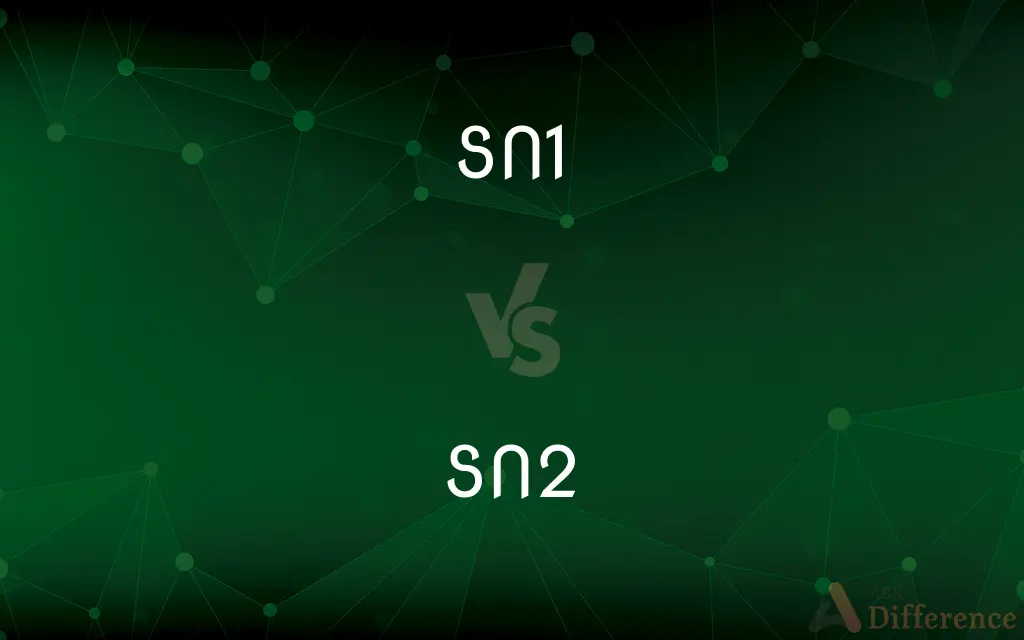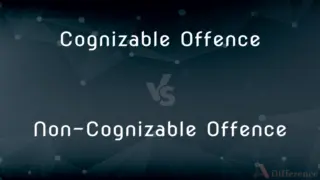SN1 vs. SN2 — What's the Difference?
Edited by Tayyaba Rehman — By Fiza Rafique — Published on December 21, 2023
SN1 refers to a two-step nucleophilic substitution reaction, often involving a carbocation intermediate, while SN2 is a one-step, concerted nucleophilic substitution that involves a direct exchange mechanism.

Difference Between SN1 and SN2
Table of Contents
ADVERTISEMENT
Key Differences
SN1 and SN2 are terms used to describe two different mechanisms of nucleophilic substitution reactions in organic chemistry. The SN in both terms stands for "substitution nucleophilic", but the way these reactions proceed is distinctly different. SN1 denotes a mechanism where the nucleophile attacks after the leaving group departs, resulting in two distinct steps.
In contrast, SN2 denotes a mechanism where the nucleophile attacks at the same time the leaving group departs, in a single concerted step. This simultaneous attack and departure make the SN2 reaction more direct in nature. While the SN1 reaction often involves the formation of a carbocation intermediate, SN2 does not form any such intermediates.
In terms of molecular stereochemistry, the outcomes of SN1 and SN2 reactions can be notably different. During an SN1 reaction, because there's a carbocation intermediate, the nucleophile can attack from either side, potentially leading to a racemic mixture of products. In an SN2 reaction, the nucleophile attacks from the opposite side of the leaving group, leading to inversion of configuration at the chiral center.
The speed of these reactions can be influenced by various factors. The rate of an SN1 reaction is typically determined by the stability of the carbocation formed, making it dependent solely on the concentration of the substrate. On the other hand, the rate of an SN2 reaction is determined by both the concentration of the substrate and the nucleophile, as they come together in a single step.
Though SN1 and SN2 both revolve around nucleophilic substitution, they represent contrasting mechanisms in organic chemistry. SN1's two-step, intermediate-dependent pathway differs significantly from SN2's direct, concerted mechanism. These differences lead to varied outcomes, especially in stereochemical aspects, and are pivotal in determining the course of the reactions.
ADVERTISEMENT
Comparison Chart
Reaction Steps
Two-step
One-step
Intermediate Formation
Carbocation formed
No intermediate
Stereochemistry Outcome
Can lead to racemic mixture
Leads to inversion of configuration
Rate Determination
Dependent on substrate concentration only
Dependent on both substrate and nucleophile
Typical Substrates
Secondary and tertiary substrates
Primary and methyl substrates
Compare with Definitions
SN1
A two-step nucleophilic substitution reaction.
Tertiary halides often undergo SN1 reactions due to carbocation stability.
SN2
A one-step, concerted nucleophilic substitution.
Methyl halides are perfect candidates for SN2 reactions due to their lack of steric hindrance.
SN1
Rate is determined by substrate concentration alone.
The speed of the SN1 reaction increased with a higher concentration of the substrate.
SN2
Leads to inversion of stereochemistry.
The product of the SN2 reaction showed complete inversion at the chiral center.
SN1
Common with substrates that form stable carbocations.
Tertiary alcohols favor the SN1 mechanism due to their ability to form stable carbocations.
SN2
Rate is influenced by both substrate and nucleophile concentrations.
The SN2 reaction rate increased when both the nucleophile and substrate concentrations were raised.
SN1
Characterized by carbocation intermediate formation.
In SN1 reactions, the rate-limiting step is the formation of the carbocation.
SN2
No intermediate is formed in the process.
The direct exchange in SN2 reactions means there's no carbocation intermediate.
SN1
Can result in racemization at chiral centers.
The chiral center in the substrate became racemic after the SN1 reaction.
SN2
Favored by substrates without steric hindrance.
Primary halides, having minimal steric hindrance, typically undergo SN2 reactions.
Common Curiosities
Why is stereochemistry affected in SN2 reactions?
In SN2, the nucleophile attacks from the opposite side of the leaving group, leading to inversion of configuration.
Can SN1 reactions lead to multiple products?
Yes, SN1 reactions can give rise to racemic mixtures due to carbocation intermediate's planar structure.
How does SN2 differ from SN1?
SN2 is a one-step, concerted process, whereas SN1 involves two steps with a carbocation intermediate.
Which reaction, SN1 or SN2, leads to an inversion of configuration?
SN2 reactions lead to inversion of configuration at the reaction center.
Are carbocations formed in SN2 reactions?
No, SN2 reactions proceed without the formation of carbocation intermediates.
What determines the rate of an SN1 reaction?
The rate of SN1 is determined solely by the concentration of the substrate.
How is the rate of an SN2 reaction determined?
The rate of SN2 is determined by the concentrations of both the substrate and the nucleophile.
Why are tertiary substrates more suited for SN1?
Tertiary substrates can form stable carbocations, favoring the SN1 mechanism.
What does SN1 stand for?
SN1 stands for "Substitution Nucleophilic Unimolecular."
Is the leaving group's ability important in both SN1 and SN2?
Yes, a good leaving group is crucial for both SN1 and SN2 reactions.
Why are primary halides less likely to undergo SN1 reactions?
Primary halides form less stable carbocations, making them less suitable for SN1.
Is steric hindrance a factor in SN2 reactions?
Yes, SN2 reactions are hindered by steric factors, making primary and methyl substrates more reactive.
How does solvent choice affect SN1 and SN2 reactions?
Polar protic solvents often favor SN1, while polar aprotic solvents favor SN2.
Can both SN1 and SN2 reactions occur simultaneously?
While it's possible under certain conditions, typically one mechanism is favored over the other based on the substrate and conditions.
Share Your Discovery

Previous Comparison
Expensive vs. Invaluable
Next Comparison
Cognizable Offence vs. Non-Cognizable OffenceAuthor Spotlight
Written by
Fiza RafiqueFiza Rafique is a skilled content writer at AskDifference.com, where she meticulously refines and enhances written pieces. Drawing from her vast editorial expertise, Fiza ensures clarity, accuracy, and precision in every article. Passionate about language, she continually seeks to elevate the quality of content for readers worldwide.
Edited by
Tayyaba RehmanTayyaba Rehman is a distinguished writer, currently serving as a primary contributor to askdifference.com. As a researcher in semantics and etymology, Tayyaba's passion for the complexity of languages and their distinctions has found a perfect home on the platform. Tayyaba delves into the intricacies of language, distinguishing between commonly confused words and phrases, thereby providing clarity for readers worldwide.
















































